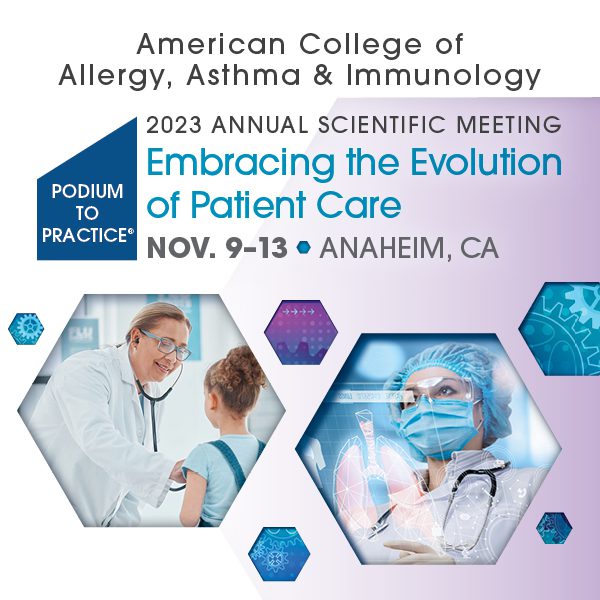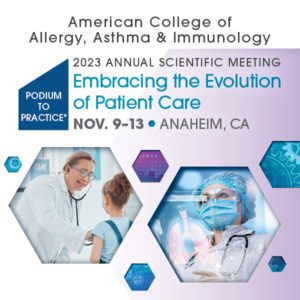November 8, 2023
Second study shows pharmacy translation software can cause complications for school medications
ANAHEIM, Calif. (Nov. 9, 2023) – About 20% of the US population speaks a language other than English when they are at home. The abundance of languages spoken in the United States can pose barriers for some allergy and asthma patients to receive appropriate care. A new study being presented at this year’s American College of Allergy, Asthma and Immunology (ACAAI) Annual Scientific Meeting in Anaheim, Calif. shows that language difficulties may cause some children to be underdiagnosed for allergic conditions such as food allergy, asthma and eczema. In addition, a new medically challenging case illustrates it is possible for pharmacy translation software to mistakenly interfere with a prescription being filled.
“We wondered if those who spoke a language other than English would be underdiagnosed for some allergic conditions,” says Hao Tseng, MD, ACAAI member and lead author on the study. “Among children with a language preference other than English, the diagnosis of asthma was less than half as common, eczema was about 2/3 as common, and allergic rhinitis was slightly more than half as common when compared with children whose preferred language was English. A similar correlation for the diagnosis of food allergy was deemed not statistically significant.
To conduct the study, a retrospective review of electronic health records (EHR) of all patients under 18 years of age who were seen from 7/1/2020 to 4/30/2023 in a primary care pediatric clinic was conducted. A total of 16,517 children were included in the study. The mean age was 6.2 years and 48.6% of children were female. The majority of children were Black (80.4%) and enrolled in Medicaid (78.9%). 14.8% of participants indicated a preference for a language other than English (4% Haitian Creole, 4% Spanish, and 6.5% other).
In an unrelated report of a medically challenging case, a Spanish-speaking 7-year-old girl was diagnosed with a fish allergy and prescribed an epinephrine autoinjector. A school medication form was completed so that the patient could have epinephrine available at school. When the prescription was sent to the pharmacy, the prescription was translated into Spanish using a translation software; however, the software made minor changes. Since the prescription no longer matched the school form exactly, the school nurse did not accept the epinephrine autoinjector, and returned it home with the student and a note. The patient’s mother was unable to read the note because it was written in English. Four months later, the patient returned to clinic with the epinephrine autoinjector and the nurse’s note.
“Patients with limited English proficiency encounter unexpected barriers to care and remain a vulnerable patient population,” says Margaret Huntwork, MD, senior author of the paper. “The pharmacy translation software is not the only thing to blame for this case of a delay in securing a potentially life-saving medication in the school setting. Communication between the family, the physician, the school nurse, and the pharmacy is essential to ensure safety and success of students with allergies.”
Abstract Title: Language Barriers are Associated with the Underdiagnosis of Allergy and Immunology Conditions in Children
Presenter: Hao Tseng, MD
Medically Challenging Case Abstract Title: Lost in Translation: Pharmacy Translation Software Mounts an Unexpected Barrier to School Medications
Presenter: Geetha Gowda, MS
For more information about allergies and asthma, or to find an allergist in your area, visit AllergyandAsthmaRelief.org. The ACAAI Annual Scientific Meeting is Nov. 9-13. For more news and research from the ACAAI Scientific Meeting, go to our newsroom and follow the conversation on X/Twitter #ACAAI23.
About ACAAI
The American College of Allergy, Asthma & Immunology (ACAAI) is a professional medical organization of more than 6,000 allergists-immunologists and allied health professionals, headquartered in Arlington Heights, Ill. Founded in 1942, the College fosters a culture of collaboration and congeniality in which its members work together and with others toward the common goals of patient care, education, advocacy, and research. ACAAI allergists are board-certified physicians trained to diagnose allergies and asthma, administer immunotherapy, and provide patients with the best treatment outcomes. For more information and to find relief, visit AllergyandAsthmaRelief.org. Join us on Facebook, Pinterest, Instagram and Twitter/X.
P240
LANGUAGE BARRIERS ARE ASSOCIATED WITH THE UNDERDIAGNOSIS OF ALLERGY AND IMMUNOLOGY CONDITIONS IN CHILDREN
H. Tseng*, M. Vastardi, Brooklyn, NY.
Introduction: Language barriers exacerbate health disparities by hindering effective communication and accurate diagnosis. Our study aims to assess the impact of language barriers on the diagnosis of common allergy and immunology conditions in children.
Methods: We conducted a retrospective review of electronic health records (EHR) of all patients under 18 years of age who were seen from 7/1/2020 to 4/30/2023 in a primary care pediatric clinic. Data on patient diagnosis and preferred language were collected from the EHR. Logistic regression was used for analysis, adjusted for age, gender, race/ethnicity, and health insurance.
Results: A total of 16,517 children were included in the study. The mean age was 6.2 years and 48.6% of children were female. The majority were Black children (80.4%) and enrolled in Medicaid (78.9%). 14.8% of participants indicated a preference for a language other than English (4.3% Haitian Creole, 4.0% Spanish, and 6.5% other). Among children with a language preference other than English, a number of diagnoses were less common, including food allergy (adjusted odds ratio [aOR]: 0.51, 95% confidence interval [CI]: 0.24-1.10), asthma (aOR: 0.42, 95% CI: 0.28-0.63), eczema (aOR: 0.69, 95% CI: 0.49-0.96), allergic rhinitis (aOR: 0.54, 95% CI: 0.30-0.96), penicillin allergy (aOR: 0.51, 95% CI: 0.27-0.96), and encounter for routine child health examination with abnormal findings (aOR: 0.80, 95% CI: 0.67-0.94).
Conclusion: Our study suggests that language barriers may contribute to the underdiagnosis of common allergy and immunology conditions and underscores the importance of providing appropriate support in this area.
M035
LOST IN TRANSLATION: PHARMACY TRANSLATION SOFTWARE MOUNTS AN UNEXPECTED BARRIER TO SCHOOL MEDICATIONS
G. Gowda*, M. Huntwork, New Orleans, LA.
Introduction: Some pharmacies use translation software that translates the prescription signetur (sig) into the patient’s preferred language. This is typically considered an innovation that improves care of limited English proficiency patients. Here, we describe how translation negatively impacted patient care.
Case Description: A Spanish-speaking 7 year-old girl was diagnosed with a fish allergy and prescribed an epinephrine autoinjector. A school medication form was completed so that the patient could have epinephrine available at school. When the prescription was sent to the pharmacy, the sig was automatically translated into Spanish using a translation software; however, the software made minor changes to the sig. Since the sig no longer matched the school form exactly, the school nurse did not accept the epinephrine autoinjector, and returned it home with the student and a note. The patient’s mother was unable to read the note because it was written in English. Four months later, the patient returned to clinic with the epinephrine autoinjector and the nurse’s note, and we pieced together the chain of events.
Discussion: Despite good intentions of innovations such as pharmacy translation software, limited English proficiency patients encounter unexpected barriers to care and remain a vulnerable patient population. The pharmacy translation software is not the only thing to blame for this case of a delay in securing a potentially life-saving medication in the school setting. Communication between the family, the physician, the school nurse, and the pharmacy is essential to ensure safety and success of students with allergies.

